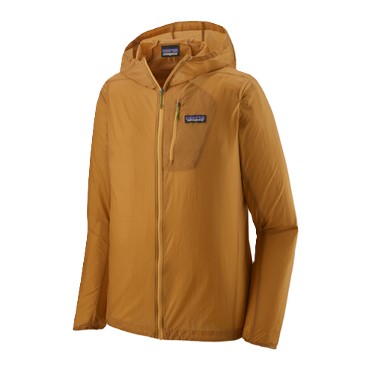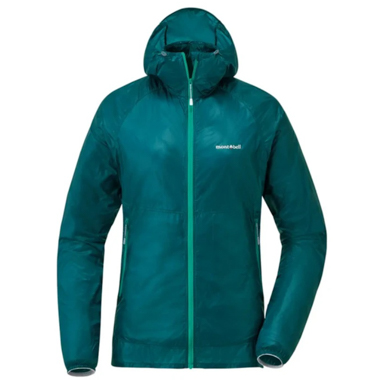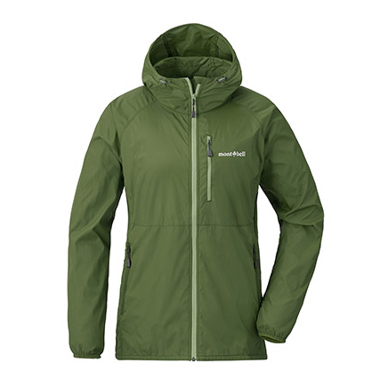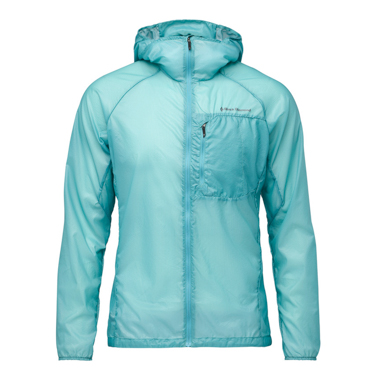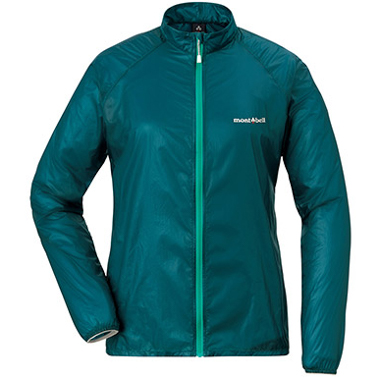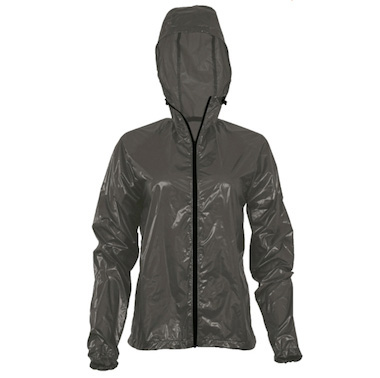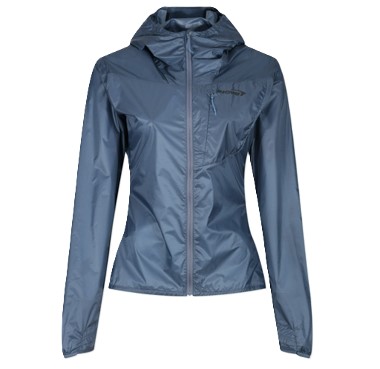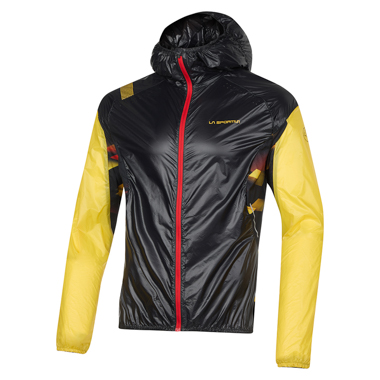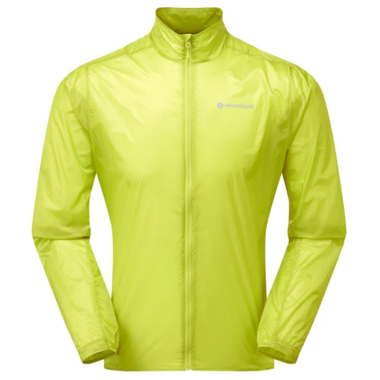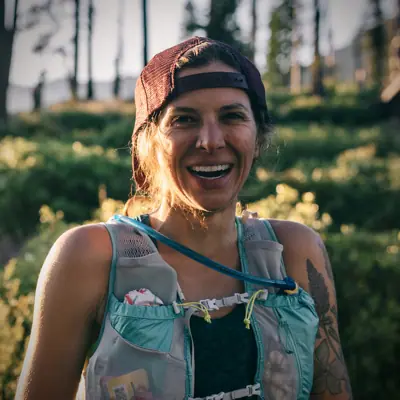
Windbreakers are useful in various running situations and are light enough to store them in a pocket. Photo: iRunFar/Eszter Horanyi
On the surface, it may be hard to figure out the features that separate the best windbreaker jackets from the rest, but the little details make all the difference. At its best, this glorious piece of apparel weighs nearly nothing, disappears into almost any corner of your hydration pack or a pocket, and keeps you comfortable in the wind and cold.
To bring you this windbreaker jacket buyer’s guide, the iRunFar team tested an array of jackets on the market in all four seasons to find out what works best — and what doesn’t. Our team of runners, including trail, ultra, and road runners, assessed jackets based on their weight, packable size, fit, breathability, and extra features.
Many of our team return to the Patagonia Houdini Jacket year after year, but we also love the Montbell Tachyon Hooded Jacket. Some of the jackets we chose were minimalists, including the hood-free Montbell Ex Light Wind Jacket, while others, like the Inov8 Windshell Windproof Jacket 2.0, had a variety of bells and whistles.
To learn more about the details of the best windbreaker jackets for running and what to consider when buying one, jump down to our recommendations for how to choose, as well as our frequently asked questions. You can also learn more about our research and testing methodology. If you’re looking for something that will keep you dry in inclement weather, be sure to check out our Best Running Rain Jackets guide.
Best Windbreaker Jackets of 2024
- Best Overall Windbreaker Jacket: Patagonia Houdini Jacket
- Best Overall Windbreaker Jacket — Runner-Up: Montbell Tachyon Hooded Jacket
- Best Reflective Windbreaker Jacket: L.L.Bean Bean Bright Multisport Jacket
- Best Budget Windbreaker Jacket: Montbell Wind Blast Hooded Jacket
- Other Great Windbreakers: Black Diamond Distance Wind Shell, Montbell Ex Light Wind Jacket, Enlightened Equipment Copperfield Wind Shirt, Inov8 Windshell Windproof Jacket 2.0, La Sportiva Blizzard Windbreaker Jkt and La Sportiva Briza Windbreaker Jkt, Montane Featherlite Nano Windproof Jacket

The Montbell Tachyon Hooded Jacket is a lightweight windbreaker that is easy to stash in any pack. Photo: iRunFar/Eszter Horanyi
Best Overall Windbreaker Jacket: Patagonia Houdini Jacket ($109)
Pros:
- Ultralight
- It packs into its own pocket
- Competitive price
Cons:
- Noisier material
An iconic windbreaker jacket and longstanding favorite among trail runners and mountain athletes, the Patagonia Houdini Jacket offers superb wind-blocking performance in an ultralight package. It features a simple design with few bells and whistles, offering ample warmth and protection for its weight.
The jacket’s cuffs feature cinched elastic to help them stay in place, and a single chest pocket can hold a chapstick or some cash for après run. Aptly named, the Houdini conveniently and easily packs into its chest pocket when not in use and is compact enough to carry in any pack or even a waistbelt. This jacket features a uniform, full-length front zipper and an adjustable hood that can fit over a climbing helmet.
Our main gripe with the Patagonia Houdini is that it’s louder and more crinkly than our other top picks that offer comparable weight and performance. That said, it’s less expensive than our favorites from Montbell, so if you’re looking to save a little bit of money, this jacket provides excellent value for the cost. It’s durable and reliable, and many of our testers have used theirs for a long time. Thus, it has also taken the top windbreaker spot in our Best Running Jackets guide.
Actual weight: 3.7 ounces (105 grams) (all weights measured in men’s medium unless otherwise noted) | Material: 1.2-ounce 100% recycled nylon ripstop with a PFC-free DWR finish
Shop the Women's Patagonia Houdini JacketShop the Men's Patagonia Houdini Jacket
Best Overall Windbreaker Jacket — Runner-Up: Montbell Tachyon Hooded Jacket ($140)
- Ultralight
- Features galore
Cons:
- Shiny material
- Seven-denier nylon fabric may be less durable than heavier jackets
If you want a jacket that compresses into a tiny little package when not in use but still provides a high level of wind protection, it’s hard to do better than the Montbell Tachyon Hooded Jacket. The low weight is a result of the 7-denier nylon fabric, the thinnest fabric used in windbreaker jackets today. It feels pretty delicate, but the ripstop nylon showed no signs of wear or tear after many months of testing.
We wore it underneath a variety of hydration packs and used it during off-trail travel, brushing up against shrubs and rocks, without noticing any damage. The thinner fabric doesn’t hold in heat as well as thicker ones, so this jacket is better suited for warmer, windy days rather than arctic breezes in the middle of winter.
This fabric has some shine, which may not appeal to everyone. An upside, however, is that it’s quiet — you don’t hear it swishing or flapping while running. Montbell packs an impressive number of features into the very lightweight jacket, including a full-length zipper, two zippered hand pockets, a hidden inner pocket with a Velcro closure, a bit of elastic at the waist, tiny underarm vents, and a drawstring hood with front pull tabs for adjustment.
The jacket also features a microfiber material on the elastic wrists for added comfort, and the back is slightly longer than the front to provide extra coverage. The material has a couple of reflective hits and a DWR finish for water resistance. We love how compact and lightweight it is, as it easily fits into our running vest and even a running belt.
This jacket also appears in our Best Running Jackets and Best Mountain Running Gear guides.
Actual weight: 2.6 ounces (73 grams) | Fabric: 7-denier ripstop nylon, what Montbell calls its Ballistic Airlight fabric
Shop the Women's Montbell Tachyon Hooded JacketShop the Men's Montbell Tachyon Hooded Jacket
Best Reflective Windbreaker Jacket: L.L.Bean Bean Bright Multisport Jacket ($99)
Pros:
- Incredibly visible in low light
- Good pockets
Cons:
- Sleeves are long
If you regularly run on roads in the dark, the L.L.Bean Bean Bright Multisport Jacket can significantly improve your visibility to cars. In one word, this jacket is bright. While most windbreakers in this guide have reflective highlights, often in the logo or other small patches, L.L.Bean definitely made this jacket for high visibility.
Not only is the shell color an eye-popping neon yellow, but the jacket also features 14 reflective hits strategically placed to enhance your visibility to passing motorists. We wouldn’t necessarily head out to a coffee shop post-run in this jacket and expect to blend in with normal society, but when it comes to safety while road running, this jacket is hard to beat.
L.L.Bean designed it as a multisport jacket, so it also has a cut that works for cyclists, meaning it has long sleeves. The longer arms weren’t necessarily a deal-breaker for any of our testers, and they’re nice for pulling down over our hands for a bit of extra protection.
The 50-denier polyester with a DWR finish makes this jacket thicker and warmer than others in this guide. Still, it has a back mesh vent, which helps with temperature control. There are also several pockets, including one zippered rear pocket and two zippered front pockets, that provide ample storage space for gloves, a hat, or small items. Two interior pockets can hold small items, and one of them is designed specifically to hold your phone with a Velcro closure.
With all its features, we also placed this jacket in our Best Running Jackets guide. And if you’re a cyclist and a runner, this is a great multi-purpose jacket for both sports.
Fabrics: 50-denier polyester
Shop the L.L.Bean Bean Bright Multisport JacketBest Budget Windbreaker Jacket: Montbell Wind Blast Hooded Jacket ($95)
Pros:
- Affordable
- High performance
- Excellent features despite being in the budget category
Cons:
- Weight
- Fabric can be a little noisy
While not ultralight nor ultra-technical, the Montbell Wind Blast Hooded Jacket is an excellent entry-level windbreaker jacket that works for almost everyone and has an approachable price point.
This is a pretty standard windbreaker jacket. It has a nice-sized hood with front pull tabs for adjustment, mesh underarm vents, two zippered mesh hand pockets, elastic wrists with microfiber panels for comfort, and a drawstring waist. It doesn’t pack into itself but comes with a separate stuff sack.
The DWR treatment provides increased weather resistance, the full-length zipper is smooth, and the back is slightly longer than the front, similar to other Montbell jackets. This jacket fits a bit loose, making it easy to put layers underneath, but you might consider sizing down if you want a more streamlined and tighter fit.
Because this jacket features 40-denier nylon, it is one of the thickest and warmest of the bunch here. One of our testers needed to unzip it for ventilation while running, even in frigid winds. While the material makes some movement noise, it is less noticeable than that of some other jackets in this guide.
Two generous hand pockets and one chest pocket provide plenty of storage. Not everyone needs an ultralight and ultra-expensive jacket, so if you want something simple and affordable, this one is for you. We appreciated the whole package so much that we included it in our Best Running Jackets guide.
Actual weight: 6.2 ounces (177 grams) | Fabric: 40-denier nylon taffeta
Shop the Women's Montbell Wind Blast Hooded JacketShop the Men's Montbell Wind Blast Hooded Jacket
Other Great Windbreakers
Black Diamond Distance Wind Shell ($149)
- Generously sized to fit over a small pack or extra layers
- Quiet fabric
- Fabric repels water longer than the other windbreaker jackets in this guide
Cons:
- Expensive
The Black Diamond Distance Wind Shell is slightly pricier than many other wind jackets in this guide, but its features and performance make it a worthwhile investment. Between the quiet fabric, generous sizing, and solid water resistance, this jacket is a favorite among iRunFar’s team.
While Black Diamond states this windbreaker jacket has a slim fit, we found it to be generously sized in all aspects, allowing it to fit over a small running pack or several layers. We appreciate that the 15-denier fabric is quiet and doesn’t look as technical as other windbreaker jackets, so you can transition to a post-run coffee or beer without looking like a space nerd.
The Distance Wind Shell’s features include a full-length zipper, a zippered chest pocket that packs into the jacket for storage, elastic wrists with a bit of microfiber for added comfort, and a generous hood that is adjustable via a drawstring at the nape of the neck. The hood fits over a climbing helmet for your scrambling adventures. The jacket’s length is the same at the front and back.
Several windbreaker jackets in this guide feature a DWR finish to repel water, but we found this fabric kept us dry the longest in a light sprinkle before wetting out. While you’ll still want to wear a proper rain jacket in inclement weather, this one can help protect you from an unexpected shower.
Actual weight: 3.6 ounces (102 grams) | Fabric: 15-denier ripstop nylon
Montbell Ex Light Wind Jacket ($110)
Pros:
- Super ultralight
- Affordable
- Packs down tiny
Cons:
- Shiny material
- Seven-denier nylon fabric may be less durable
The Montbell Ex Light Wind Jacket is another winner from the brand, this time in the super-ultralight category, weighing just 1.6 ounces (47 grams). Think of this jacket as a pared-down version of the Montbell Tachyon Hooded Jacket reviewed above. It is simpler but still protects you from the wind.
When compared to the Montbell Tachyon Hooded Jacket, this jacket keeps the same seven-denier ripstop nylon fabric, full-length zipper, underarm vents, elastic wrists with the microfiber panels, a bit of elastic at the waist, the small pocket with the Velcro closure (but this time on the outside of the jacket), the DWR finish, and the reflective hits. But it loses the hood, two zippered hand pockets, and a full ounce of weight.
We love that it packs down incredibly small, fitting in the palm of your hand — it’s about the size of a Clif Bar. It’s so small you could even stuff it into a large pocket in a pair of running shorts. You can check out which high-quality shorts on the market have big enough pockets in our Best Running Shorts for Men or Best Running Shorts for Women guides.
Again, this fabric is quiet and quite thin, but it remains durable even when we brush against rocks and vegetation. Whether you’re looking for a windbreaker that you can start a run in and then take off and carry easily, or one to keep in your pack as a just-in-case layer that is light enough to forget you’re carrying, this is a great option.
Actual weight: 1.6 ounces (47 grams) | Material: 7-denier ripstop nylon, what Montbell calls its Ballistic Airlight fabric
Shop the Women's Montbell Ex Light Wind JacketShop the Men's Montbell Ex Light Wind Jacket
Enlightened Equipment Copperfield Wind Shirt ($120)
Pros:
- Super ultralight
- Protective hood
- Fits over a running pack
- Size inclusive
Cons:
- Shiny material
- Not ideal for casual wear
Made by a small company in Winona, Minnesota, the Enlightened Equipment Copperfield Wind Shirt is the best-performing hooded super ultralight jacket we’ve tested, even if its ultra-shiny fabric means it’s not the prettiest in the bunch. It’s not the jacket you’d grab for a coffee shop run. But, weighing a magical 1.8 ounces (51 grams), it’s so small that there’s no reason not to take it along on a run as a just-in-case layer.
Made from 10-denier nylon, the fabric is light but effectively blocks wind. It has a very robust waist cinch, so you can pull it tight against you to keep out all the breeze, and it is the same length around from front to back. You can adjust the hood from the front with an elastic cinch. The wrists have elastic for security, too. We also love that it’s a quiet fabric that makes very little noise when you’re running or in the wind.
As Enlightened Equipment states on its website, this jacket runs very big for its size, both in width and length. If you prefer a sleeker jacket, size down. On the other hand, choosing your standard jacket size will likely mean the jacket will fit over several layers and a modest running pack — we tested up to 12 liters underneath the jacket, and it works!
In addition, the Enlightened Equipment Copperfield Wind Shirt comes in the widest variety of sizes of all the jackets we tested.
Actual weight: 1.8 ounces (51 grams) | Fabric: 10-denier nylon
Shop the Women's Enlightened Equipment Copperfield Wind ShirtShop the Men's Enlightened Equipment Copperfield Wind Shirt
Inov8 Windshell Windproof Jacket 2.0 ($90)
Pros:
- Ample features
- Low weight and price
Cons:
- Louder material
While it’s in the middle of the pack for both weight and price, the Inov8 Windshell Windproof Jacket 2.0 has excellent features that make it stand out from the rest. It’s also one of the least expensive jackets in this guide.
Price aside, let’s talk about the features. Double layers on the front for extra protection! Thumb holes! An earphone cord hole in the zippered chest pocket! A chest snap that keeps the jacket in place when you want it unzipped to stay cool, but don’t want it to flap around in the wind! Another snap to stow the hood when you don’t need it! A hood crest to keep water off your face! Elastic on the hood, wrists, and waist! Reflective hits! And all this on a jacket weighing just 2.8 ounces (80 grams) makes it truly extraordinary.
The jacket also features a waist that is significantly longer in the back than in the front for added protection. The waist and hood aren’t adjustable, but their fitted construction works well enough to make adjustment points unnecessary. The 20-denier recycled ripstop nylon does crinkle in the wind and makes a fair bit of noise, but that’s our only gripe. As we said, it’s not the lightest or the cheapest, but this jacket’s attention to detail and feature-packed design have won us over.
Actual Weight: 2.8 ounces (80 grams) | Fabrics: 20-denier ripstop nylon; the front fabric is windproof, while the back fabric is more breathable
Shop the Women's Inov8 Windshell Windproof Jacket 2.0Shop the Men's Inov8 Windshell Windproof Jacket
La Sportiva Blizzard Windbreaker Jkt and La Sportiva Briza Windbreaker Jkt ($120)
- Light
- Breathes well
- Slim fit
Cons:
- Some colorways are very bright
- Not intended for casual wear
The men’s La Sportiva Blizzard Windbreaker Jkt and women’s La Sportiva Briza Windbreaker Jkt may have some of the loudest colorways of the windbreakers on this list, but they’re also some of the lightest and most breathable. The material is so thin, in fact, that the lighter colorways are almost translucent.
This is definitely not a jacket that is going to blend in well at a coffee shop after a run, but if you want a windbreaker that can scrunch up into nothing to live in your pack as a just-in-case layer while still providing ample protection against ridgetop winds, it’s easy to look past the very European styling of these jackets, even if you’re someone more into subdued colors and designs.
The thin polyamide material is made of mostly recycled products and is Bluesign-approved. The front of the jacket includes solid, windproof material, while the back has a mesh panel for increased breathability. The underarms are also perforated to help dump heat when you’re working hard. This isn’t a jacket for the windiest conditions, but we found that it did the trick for all but gale-force winds.
It features a PFC-free DWR coating, allowing it to withstand a light drizzle if you get caught in the rain. The hood has an adjustable elastic cord around it so that you can snug it down, and there’s also elastic around the wrists and the waist to seal in heat and keep the jacket from flapping around. As is typical of La Sportiva apparel, this jacket features a slim cut, so if you’re between sizes, consider sizing up.
A small mesh pocket provides minimal storage, but this is definitely a minimalist jacket with few bells and whistles.
Actual Weight (Women’s Medium): 2.9 ounces (83 grams) | Fabrics: Polyamide, polyester, elastane with a PFC-free DWR finish
Montane Featherlite Nano Windproof Jacket ($130)
- Very light
- Fits into the palm of a hand
Cons:
- Potential durability issues with thin fabric
- No hood
The Montane Featherlite Nano Windproof Jacket is one of the lightest and smallest windbreakers out there. It’s a no-frills, no-nonsense jacket that does the job simply and efficiently in 1.8 ounces (51 grams). Made of 10-denier 100% recycled ripstop nylon, the material is quite thin, though not as thin as some of the 7-denier options listed above.
While we haven’t had any issues with the durability, this isn’t a jacket we’d feel particularly comfortable taking on an off-trail adventure. A PFC-free DWR coating helps with its weather resistance. The elastic around the cuffs and a bit of elastic around the hem keep the jacket in place, and the full zipper makes it easy to put the jacket on and off, allowing for temperature regulation. Reflective hits on the chest and back help increase the visibility of this jacket during low-light runs. The lack of a hood, for better or worse, also helps shave a few grams off of this jacket.
While all the features of this jacket are impressive, it’s really the weight and packability that set it apart from other options on the market. When packed away in the internal stuff pocket, this jacket easily fits into a hand or running belt. It’s small enough and light enough that our tester, who generally shies away from carrying anything on a run if he can avoid it, is happy to bring it along as a just-in-case layer.
It’s not a jacket that provides the same level of protection as some of the heavier windbreakers in this guide, but for runs where you just need a bit of wind protection and warmth during an otherwise warm run, it’s a great option to have around.
Actual weight: 1.8 ounces (51 grams) | Material: 10-denier recycled ripstop nylon
Comparing the Best Windbreaker Jackets
| WINDBREAKER | PRICE | WEIGHT | MATERIALS |
| Patagonia Houdini Jacket | $109 | 3.7 ounces | 1.2-ounce 100% recycled nylon ripstop |
| Montbell Tachyon Hooded Jacket | $140 | 2.6 ounces | 7-denier ripstop nylon |
| L.L.Bean Bean Bright Multisport Jacket | $100 | Not listed | 50-denier polyester |
| Montbell Wind Blast Hooded Jacket | $89 | 6.2 ounces | 40-denier nylon taffeta |
| Black Diamond Distance Wind Shell | $149 | 3.6 ounces | 15-denier ripstop nylon |
| Montbell Ex Light Wind Jacket | $110 | 1.6 ounces | 7-denier ripstop nylon |
| Enlightened Equipment Copperfield Wind Shirt | $120 | 1.8 ounces | 10-denier ripstop nylon |
| Inov8 Windshell Windproof Jacket 2.0 | $90 | 2.8 ounces | 20-denier ripstop nylon |
| La Sportiva Blizzard Windbreaker Jkt | $120 | 2.9 ounces | Polyamide, polyester, elastane |
| Montane Featherlite Nano Windproof Jacket | $130 | 1.8 ounces | 10-denier recycled ripstop nylon |
Buyer’s Guide: How to Choose the Best Windbreaker Jacket for Running
Fit
Ultimately, the fit of a jacket is the most important factor to consider. Whether you want a jacket that provides a snug fit or one that you can fit multiple layers — or even a pack under — comes down to personal preference. The best windbreaker for running will, at minimum, cover your wrists well and stay below your waistline when you raise your arms.
Many of the jackets in this guide, like the Montbell Wind Blast Hooded Jacket, are longer in the back to provide extra protection, especially when bending over to tie your shoelaces or pick something up. Some jackets, like the Enlightened Equipment Copperfield Wind Shirt, are designed to fit a pack underneath and run big.
Most windbreakers include nylon or polyester, materials that don’t have a lot of stretch. Because of this, you might want to consider sizing up if you’re between sizes or looking for a roomier fit.
When sizing up, one thing to consider is that windbreaker material tends to be a bit noisier when flapping in the wind, and extra material can make a lot of noise. The material of the Montbell Tachyon Hooded Jacket is one of the quietest in this guide. If you’re sensitive to noise while running, please disregard our recommendation to size up.

iRunFar’s Alli Miles tests the Black Diamond Distance Wind Shell during a run on Ventura County, California, trails. Photo: iRunFar/Eszter Horanyi
Protection
Protection from the elements — namely, wind and the cold air it brings — is why you are searching for the best windbreaker.
Remember that even the best windbreaker jackets are not waterproof or meant to serve as rain jackets. However, most windbreaker jackets feature nylon or polyester, which naturally repel a little water. Several windbreaker jackets in this guide, like the Patagonia Houdini Jacket, have a water-resistant coating that can ward off light moisture.
The jackets in this guide range in thickness. For example, the L.L.Bean Bean Bright Multisport Jacket uses 50-denier material, the thickest of this guide. This thicker material will provide extra warmth compared to a jacket like the Montbell Tachyon Hooded Jacket, which features 7-denier material. Nylon or polyester windbreaker jackets, even when the material is thin, provide excellent protection from the wind.
Windbreakers are often fairly barebones jackets, designed to stay as light as possible, but this occasionally comes at the expense of providing less protection. The lightest and least protective jacket would be one with no hood, loose cuffs, and a non-adjustable waistline.
We consider the Enlightened Equipment Copperfield Wind Shirt to be the most minimalist jacket in this guide, but even that has a hood. For improved protection, look for a jacket with an adjustable hood, fitted cuffs, and a waist cinch.
While a sleek-fitting jacket can feel good and be lighter, buying a jacket that is a bit bigger than you normally would means you can wear it over a running pack, which makes it easier to put on and take off on the move. Some jackets, like the La Sportiva Blizzard Windbreaker Jkt or La Sportiva Briza Windbreaker Jkt, have a much slimmer cut than others.

We named the Montbell Wind Blast Hooded Jacket our favorite budget windbreaker. Photo: iRunFar/Eszter Horanyi
Weight
The lighter your clothing and gear, the easier it is to carry and run with it. Windbreaker jackets offer some incredible bang for your buck in terms of being a protective garment with a very low weight. That said, there is still significant variation in windbreaker jacket weight — the jackets in this guide vary from 1.6 ounces (47 grams) to 6.2 ounces (177 grams).
If you’re a gram-counter looking for the lightest windbreaker jacket, we recommend the hoodless Montbell Ex Light Wind Jacket or the hooded Enlightened Equipment Copperfield Wind Shirt.
The more bells and whistles a jacket has — like pockets, zippers, and hoods — the heavier it will be. The jacket’s material is the main contributor to its weight, and the 50-denier nylon of the L.L.Bean Bean Bright Multisport Jacket is thicker, heavier, and likely more durable than the 7-denier nylon of the Montbell Tachyon Hooded Jacket. While even the lightest jackets do a great job of stopping the wind, you may have to be extra careful on brushy or overgrown terrain to avoid ripping their thinner fabric.

The Enlightened Equipment Copperfield Wind Shirt is shiny, ultralight, and very protective. Photo: iRunFar/Eszter Horanyi
Storage
Everyone loves pockets, but as we’ve mentioned, there’s a tradeoff to adding more features to a jacket: more storage tends to result in a heavier jacket. For some people, a single chest pocket for a key will suffice, while others will appreciate the standard side pockets to keep hands warm or store light objects.
An ultraminimalist jacket like the Enlightened Equipment Copperfield Wind Shirt won’t have any pockets, while something with a few more features, like the Inov8 Windshell Windproof Jacket 2.0, will have multiple.
In our experience, anything you want to stick in a windbreaker pocket needs to be pretty light so that it doesn’t bounce. For example, we have trouble carrying our phones in these pockets but find gloves and a hat store easily. And, of course, if you want somewhere to keep your hands warm during a break in your run, they can be convenient for that purpose.

Windbreakers are great for wearing during warm-ups and are easy to stash in a pocket or running belt afterward. Photo: iRunFar/Eszter Horanyi
Packability
The packability of a jacket often goes hand in hand with weight — usually, the lighter the jacket, the more packable it is. Some jackets, like the Patagonia Houdini Jacket, have an internal pocket where you can stuff and store it, producing a package no bigger than your fist. While this feature is convenient, we, more often than not, just find ourselves tying an unneeded windbreaker around our waist rather than dealing with stuffing it into a sack.
Other jackets in this guide, like the L.L.Bean Bean Bright Multisport Jacket, are bulkier but provide increased insulation. Ultimately, the best windbreaker is one you’re willing to carry, and extra weight and bulk make a difference.
Layering
Layering is the secret to temperature regulation for every outdoor athlete. Each time we venture outside, we try to wear and carry layers that, when worn together, keep us cozy in the worst weather we find on that outing and don’t cause us to overheat when we strip down to our last layer. The best running windbreakers can accommodate a variety of layers underneath.
When adding a windbreaker jacket to your running kit, consider how you might wear it with your other clothing and adequately size it to fit over various layers. For instance, you might consider sizing up if you suspect you’ll wear an insulating layer, but if you think you’ll only need one shirt underneath during most runs, size normally.
Some jackets, like the Enlightened Equipment Copperfield Wind Shirt, run very large to accommodate several layers and even a running pack underneath, while the La Sportiva Blizzard Windbreaker Jkt or La Sportiva Briza Windbreaker Jkt run quite slim.

We love the thumb loop and front button features of the Inov8 Windproof Windshell Jacket. Photo: iRunFar/Eszter Horanyi
Why You Should Trust Us
Many iRunFar team members live in the mountains, where some of the most unpredictable weather can occur. We’re used to runs that may be quiet and calm at lower altitudes, but as soon as we crest a ridgeline, we get blasted by huge gusts of wind. We are committed to testing the best products available in a variety of conditions, so you don’t have to suffer through the trial and error of wearing different jackets in challenging elements.
We started developing this windbreaker jacket guide by researching roughly 70 jackets from various brands. From there, we polled the large team at iRunFar on their favorite jackets and deeply investigated their features before choosing which jackets to test to find the best windbreaker possible.
For the initial testing phase, we took 22 windbreaker jackets to the field for testing over four seasons in Colorado, Utah, Alaska, and several Western European countries. Since the initial publication of this guide, we’ve continued to test new windbreakers and use the ones included here to ensure they meet all of our durability standards. Ultimately, the jackets we selected for this guide represent the best we could find after conducting several hundred hours of comprehensive testing in every imaginable condition.

Donning a windbreaker can help you ward off the cold when running on high ridgelines. Photo: iRunFar/Eszter Horanyi
Frequently Asked Questions About Windbreaker Jackets for Running
Is there a difference between men’s and women’s windbreaker jackets?
Along with other clothing items, brands design men’s and women’s jackets differently to accommodate different body shapes. Broad versus narrow shoulders, a straight cut versus a waist taper, and differences in hip widths are just a few of the distinctions between jackets designed for various body types.
Of course, we always recommend choosing a jacket that fits your body best, regardless of who the brand designed it for. Most brands make equivalent models in men’s and women’s jackets, including the Montbell Tachyon Hooded Jacket and the Inov8 Windshell Windproof Jacket 2.0.
What size windbreaker should I buy to layer clothing underneath?
The best way to buy a jacket is to visit a store and try it on, but this isn’t realistic for many people, especially when looking for a specific jacket. Brand sizing guides are the next best option for a properly fitting jacket. Brands will generally give exact measurements, including chest, waist, and hip size, and sometimes even sleeve length and shoulder width, to ensure you get the right-sized jacket.
Generally, if you plan to wear only a single layer underneath, a windbreaker jacket will fit your regular running top size. You may want to size up if you plan to layer heavier clothing or multiple elements, such as your running vest or belt, underneath. There will be some exceptions, like the Enlightened Equipment Copperfield Wind Shirt, which runs large to accommodate extra layers. Size guides when shopping online will generally inform you if a jacket runs small, large, or true to size.

The Montane Featherlite Nano Windproof Jacket is a hoodless windbreaker that weighs virtually nothing and compresses into the palm of your hand. Photo: iRunFar/Eszter Horanyi
Should I prioritize lighter weight or increased protection?
The good news is that with modern windbreaker jackets, you can have both simultaneously! We consider all the jackets in this guide lightweight and protective against the wind. Even the thinnest windbreaker jacket material can be pretty darn wind-resistant. Additionally, windbreaker jackets can be so light because they generally lack extensive features.
However, other elements increase a windbreaker jacket’s protection — like an adjustable hood, waist cinch, and elastic wrist cuffs — with only super-small weight penalties. The ultralight Enlightened Equipment Copperfield Wind Shirt has a nice waist cinch and elastic at the wrists while weighing under two ounces. The Montbell Ex Light Wind Jacket cuts as many features as possible, including a hood, to stay as light as possible.
Is my windbreaker jacket waterproof?
Most windbreakers are water-resistant but not waterproof. Rain jackets and windbreakers are two completely different types of jackets, and while you can safely use a rain jacket as a windbreaker, the opposite doesn’t hold true.
Many of the jackets in this guide, including the Patagonia Houdini Jacket, feature a DWR coating that repels light moisture, preventing the jacket from soaking through immediately under a light sprinkle. But beyond very light precipitation, a windbreaker won’t substitute for a rain jacket. If you’re running in wet weather, consider checking out the jacket options from our Best Running Rain Jackets guide.

Whether on the road or trail, windbreakers are a key piece of running gear on chilly mornings. Photo: iRunFar/Eszter Horanyi
Does my windbreaker jacket need a hood?
While the notion that you lose 30% of your heat through your head isn’t accurate — the reality is it’s about 7% — covering your head is still a quick way to stay warmer. For this reason, our testers generally prefer windbreakers with a hood, especially since the addition of a hood comes at a minimal weight penalty.
That said, some people hate the sound of material swishing next to their ears and would never actually wear the hood. If you’re one of these people, you might want a hoodless jacket like the Montbell Ex Light Wind Jacket.
If you opt for a jacket with a hood, consider whether you’re comfortable with the hood flapping around when not in use, or if you prefer a jacket that secures it when it’s not covering your head. Several of the jackets in this guide feature an elastic strap, a button, or another method for packing the hood away when you don’t want to cover your head.
We love the feature-packed Inov8 Windshell Windproof Jacket 2.0, which can stow its hood with a snap closure. Alternatively, you can try shoving the hood down the back of the jacket, but that might not work in all conditions.
Why do I need a windbreaker jacket?
Wind jackets are an incredibly versatile piece of running kit. You can wear them in windy conditions to minimize heat loss, and they are great at providing extra warmth on chilly morning runs. While we’re not saying everyone needs a windbreaker, they are great options for everything from neighborhood runs in the winter to wild ridgelines in the mountains.
When it comes to protective apparel, windbreakers are generally reasonably priced and will last a really long time. Even cheaper options, like the Montbell Wind Blast Hooded Jacket, will do an excellent job of keeping the wind away from your body, so it can’t rob you of heat. Windbreakers excel in cold, dry environments but struggle in high humidity or rain.
Why are running jackets so expensive?
A great jacket doesn’t have to break the bank. The Montbell Windblast Hooded Jacket and the Inov8 Windshell Windproof Jacket 2.0, both priced around $90, are pretty affordable pieces of running kit.
The cost of a product generally increases with added features and decreased weight, as additional parts, higher-end materials, and extra labor increase costs. Lighter materials may be more challenging to sew, and the design may require tighter tolerances during sewing and construction.
Ultimately, most of the cost of a product comes from the development of material technology. The fact that the 7-denier material of the Montbell Tachyon Hooded Jacket is durable enough for off-trail use is an impressive feat in material engineering.
Call for Comments
- What is your favorite windbreaker jacket, and why? Leave a comment to share about yours, and we’ll consider it for the next round of testing!
- Do you have separate jackets for wind and rain for the climate you run in?
